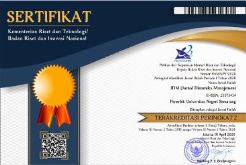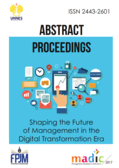The Behavioral Intention of Blockchain Adoption
Abstract
Despite the growing urgency, discussions about the diffusion of this technology are still challenging to identify and understand. This study attempts to investigate further the intention of blockchain adoption in society. This study used a survey strategy and was analysed using structural equation modelling. Furthermore, this study collected 96 respondents using a purposive sampling technique. The findings show that a few hypotheses diverged from the developed model. Blockchain adoption is suitable for today's problems and has a relative advantage over other technologies in influencing individual perceptions. However, the limited knowledge of society makes blockchain adoption only focused on a particular context. The role of the social environment is more visible in its significance on the intention to adopt blockchain technology along with individual perceptions. The research model attempted to extend the existing technology adoption behaviour theory widely used to understand technological adoption.
Keywords
Full Text:
PDFReferences
Ajzen, I. (1985). From Intentions to Actions: a Theory of Planned Behavior. Action Control, 11–39.
Ajzen, I., & Sheikh, S. (2013). Action Versus Inaction: Anticipated Affect in the Theory of Planned Behavior. Journal of Applied Social Psychology, 43(1), 155–162.
Angelis, J., & da Silva, E. R. (2019). Blockchain Adoption: a Value Driver Perspective. Business Horizons, 62(3), 307–314.
Brilliantova, V., & Thurner, T. W. (2019). Blockchain and the Future of Energy. Technology in Society, 57, 38–45.
Caiazza, R., & Volpe, T. (2017). Innovation and Its Diffusion: Process, Actors and Actions. Technology Analysis and Strategic Management, 29(2), 181–189.
Chen, Y. (2018). Blockchain Tokens and the Potential Democratization of Entrepreneurship and Innovation. Business Horizons, 61(4), 567–575.
Christidis, K., & Devetsikiotis, M. (2016). Blockchains and Smart Contracts for the Internet of Things. IEEE Access, 4, 2292–2303.
Deloitte. (2019). Deloitte’s 2019 Global Blockchain Survey Blockchain Gets Down to Business. In Delloite.
Djafarova, E., & Rushworth, C. (2017). Exploring the Credibility of Online Celebrities’ Instagram Profiles in Influencing the Purchase Decisions of Young Female Users. Computers in Human Behavior, 68, 1–7.
Duffett, R. G. (2015). Facebook Advertising’s Influence on Intention-to-Purchase and Purchase amongst Millennials. Internet Research, 25(4), 498–526.
Friedlmaier, M., Tumasjan, A., & Welpe, I. M. (2017). Disrupting Industries with Blockchain: the Industry, Venture Capital Funding, and Regional Distribution of Blockchain Ventures. SSRN Electronic Journal.
Hackius, N., & Petersen, M. (2017). Blockchain in Logistics and Supply Chain: Trick or Treat? Digitalization in Supply Chain Management and Logistics.
Hair, J. F., Risher, J. J., Sarstedt, M., & Ringle, C. M. (2019). When to Use and How to Report the Results of PLS-SEM. European Business Review, 31(1), 2–24.
Hossain, M. (2021). Frugal Innovation and Sustainable Business Models. Technology in Society, 64.
Jusuf, D. I., & Munandar, D. (2021). The Effect of Consumers’ Behavior and Perceived Risk on Purchase Decision among Online Shop Consumers. Trikonomika, 20(2), 90–96.
Klarin, A. (2020). The Decade-long Cryptocurrencies and the Blockchain Rollercoaster: Mapping the Intellectual Structure and Charting Future Directions. Research in International Business and Finance, 51( July 2019).
Koenig-Lewis, N., Marquet, M., Palmer, A., & Zhao, A. L. (2015). Enjoyment and Social Influence: Predicting Mobile Payment Adoption. Service Industries Journal, 35(10), 537–554.
Lin, W. R., Lin, C.-Y., & Ding, Y.-H. (2020). Factors affecting the Behavioral Intention to Adopt Mobile Payment: An Empirical Study in Taiwan. Mathematics, 8(10), 1–19.
Mettler, M. (2016). Blockchain Technology in Healthcare: The Revolution Starts Here. IEEE 18th International Conference on E-Health Networking, Applications and Services, 1–3.
Mottaleb, K. A. (2018). Perception and Adoption of a New Agricultural Technology: Evidence from a Developing Country. Technology in Society, 55(April), 126–135.
Nakamoto, S. (2008). Bitcoin: A peer-to-peer electronic cash system.
Nelms, T. C., Maurer, B., Swartz, L., Mainwaring, S., & Collaborative, F. of M. R. (2018). Social Payments: Innovation, Trust, Bitcoin, and the Sharing Economy. Theory, Culture and Society, 35(3), 13–33.
Pereira, J., Tavalaei, M. M., & Ozalp, H. (2019). Blockchain-based Platforms: Decentralized Infrastructures and Its Boundary Conditions. Technological Forecasting and Social Change, 146, 94–102.
Purusottama, A., Simatupang, T. M., & Sunitiyoso, Y. (2023). The Coexistence of Blockchains and Business Models (Innovation): a Systematic Review. International Journal of Innovation Science.
Queiroz, M. M., & Wamba, S. F. (2019). Blockchain Adoption Challenges in Supply Chain: an Empirical Investigation of the Main Drivers in India and the USA. International Journal of Information Management, 46, 70–82.
Rajnak, V., & Puschmann, T. (2020). The Impact of Blockchain on Business Models in Banking. Information Systems and E-Business Management, 19(3).
Rassanjani, S., Herizal, Mukhrijal, Alqarni, W., & Usman, B. (2021). Managing Creativity and Innovation in the 4 th Industrial Revolution : Learning from Giants. Journal of Innovation in Business and Economics, 05(1), 15–22.
Rogers, E. M. (2003). Diffusion of Innovations (Fifth). Free Press.
Ruggieri, R., Savastano, M., Scalingi, A., Bala, D., & D’Ascenzo, F. (2018). The impact of Digital Platforms on Business Models: an Empirical Investigation on Innovative Start-Ups. Management and Marketing, 13(4), 1210–1225.
Savastano, M., Amendola, C., & D’Ascenzo, F. (2018). How Digital Transformation is Reshaping the Manufacturing Industry Value Chain: the New Digital Manufacturing Ecosystem Applied to a Case Study from the Food Industry. Lecture Notes in Information Systems and Organisation, 24, 127–142.
Schmidt, C. G., & Wagner, S. M. (2019). Blockchain and Supply Chain Relations: a Transaction Cost Theory Perspective. Journal of Purchasing and Supply Management, 25(4), 100552.
Song, M., & Wang, S. (2018). Market Competition, Green Technology Progress and Comparative Advantages in China. Management Decision, 56(1), 188–203.
Weijters, B., Cabooter, E., & Schillewaert, N. (2010). The Effect of Rating Scale Format on Response Styles: the Number of Response Categories and Response Category Labels. International Journal of Research in Marketing, 27(3), 236–247.
Xu, Y., Goedegebuure, R., & Van der Heijden, B. (2007). Customer Perception, Customer Satisfaction, and Customer Loyalty Within Chinese Securities Business. Journal of Relationship Marketing, 5(4), 79–104.
View Counter: Abstract - 892 and PDF - 531
Refbacks
- There are currently no refbacks.





